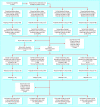Twice weekly fluticasone propionate added to emollient maintenance treatment to reduce risk of relapse in atopic dermatitis: randomised, double blind, parallel group study
- PMID: 12816824
- PMCID: PMC162129
- DOI: 10.1136/bmj.326.7403.1367
Twice weekly fluticasone propionate added to emollient maintenance treatment to reduce risk of relapse in atopic dermatitis: randomised, double blind, parallel group study
Abstract
Objective: To explore the efficacy and safety of fluticasone propionate, cream and ointment, applied twice weekly in addition to maintenance treatment with emollients, in reducing the risk of relapse of chronic recurrent atopic dermatitis.
Design: Randomised, double blind, parallel group study of 20 weeks' duration.
Setting: Dermatology outpatient clinics (6 countries, 39 centres).
Participants: Adult (aged 12-65) patients with moderate to severe atopic dermatitis who were experiencing a flare.
Methods: Participants applied fluticasone propionate (0.05% cream or 0.005% ointment; once or twice daily) regularly for four weeks to stabilise their condition. The patients whose disease was brought under control then continued into a 16 week maintenance phase, applying emollient on a daily basis with a bath oil as needed and either the same formulation of fluticasone propionate or its placebo base (emollient alone) twice weekly to the areas that were usually affected.
Main outcome measure: Time to relapse of atopic dermatitis during maintenance phase.
Results: 376 patients entered the stabilisation phase, and 295 continued into the maintenance phase. After 16 weeks in the maintenance phase, the disease remained under control in 133 patients (87 using fluticasone propionate twice weekly, 46 using emollient alone), 135 (40 fluticasone propionate, 95 emollient) had experienced a relapse, and 27 had discontinued. Median time to relapse was six weeks for emollient alone compared with more than 16 weeks for additional fluticasone propionate. Patients who applied fluticasone propionate cream twice weekly were 5.8 times less likely (95% confidence interval 3.1 to 10.8, P < 0.001) and patients using fluticasone propionate ointment 1.9 times less likely (1.2 to 3.2, P=0.010) to have a relapse than patients applying emollient alone. The groups showed no differences in adverse events.
Conclusion: After atopic dermatitis had been stabilised the addition of fluticasone propionate twice weekly to maintenance treatment with emollients significantly reduced the risk of relapse.
Figures



References
-
- Hanifin JM, Tofte SJ. Update on therapy of atopic dermatitis. JACI 1999;104: S123-5. - PubMed
-
- Cork MJ. The importance of the skin barrier function. J Dermatol Treatment 1997;8: S7-13.
-
- Van der Meer JB, Glazenburg EJ, Mulder PG, Eggink HF, Coenraads PJ. The management of moderate to severe atopic dermatitis in adults with topical fluticasone propionate. Br J Dermatol 1999;140: 1114-21. - PubMed
Publication types
MeSH terms
Substances
LinkOut - more resources
Full Text Sources
Other Literature Sources
